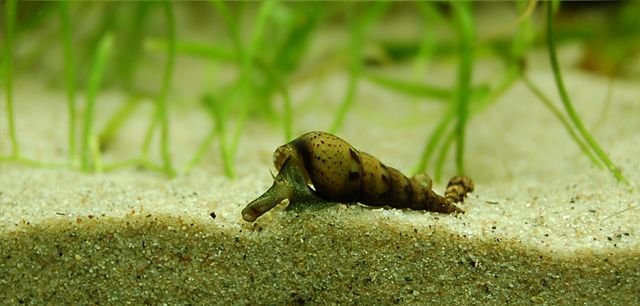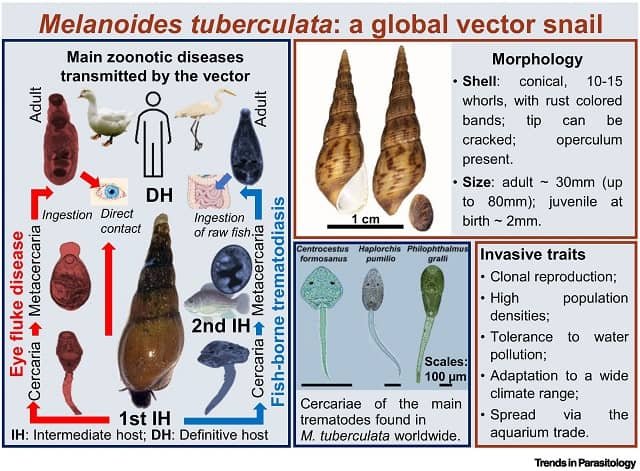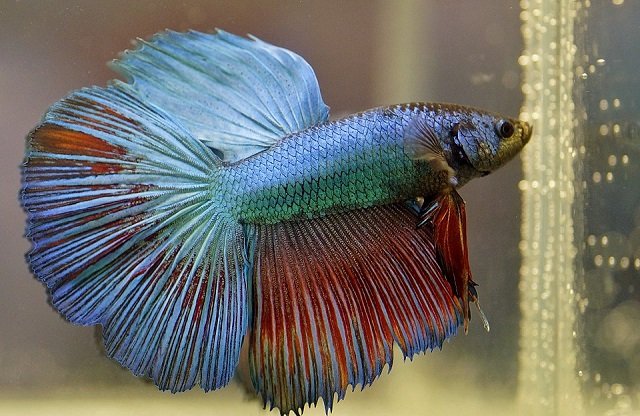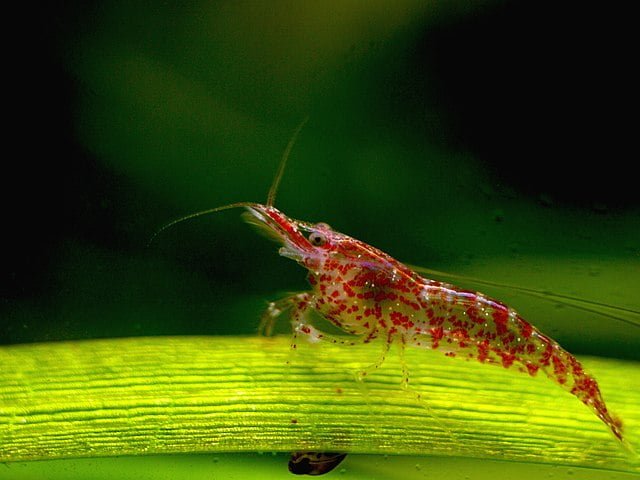
The Malaysian Trumpet Snail (Melanoides tuberculata) is a freshwater snail species native to Southeast Asia. Its popularity in aquariums stems from its ability to keep tanks clean and its remarkable reproduction rate.
Despite its “benefits” for aquarium maintenance, M. tuberculata is known as an invasive species that has colonized a wide variety of aquatic habitats. This has raised concerns due to its role as a vector for trematode parasites that can affect humans and other animals (Jihad y Makawi, 2022).
This article details the characteristics, care, reproduction, and important considerations for managing Malaysian Trumpet Snails in aquariums. Additionally, we describe the main impacts of these snails’ invasions on natural ecosystems and the risks they pose to human health.
Characteristics of the Malaysian Trumpet Snail
- 1 Characteristics of the Malaysian Trumpet Snail
- 2 Natural Habitat of the Malaysian Trumpet Snail
- 3 What Does the Malaysian Trumpet Snail Eat?
- 4 Caring for the Malaysian Trumpet Snail
- 5 Reproduction and Life Cycle
- 6 Compatibility of Malaysian Trumpet Snails (Melanoides tuberculata)
- 7 Infestations of Malaysian Trumpet Snails
- 8 Conclusion
- 9 References
- 10 Entradas relacionadas:
Taxonomy
- Kingdom: Animalia
- Phylum: Mollusca
- Class: Gastropoda
- Subclass: Caenogastropoda
- Family: Thiaridae
- Genus: Melanoides
- Species: Melanoides tuberculata (Müller, 1774)
- Subspecies: Melanoides tuberculata dadiana, Melanoides tuberculata monolithica, Melanoides tuberculata tegalensis, and Melanoides tuberculata tuberculata
- Synonyms: Nerita tuberculata, Melania tuberculata, Melanoides fasciolata
- Common Names (English): Red-rimmed Melania, Malaysian Trumpet Snail, Malaysian Burrowing Snails, Malayan Livebearing Snails, Malaysian Sails, MTS, Trumpet Snails, or Trumpets.
Ling et al., (2022) described the first mitochondrial genome of M. tuberculata based on whole-genome sequencing data. The complete mitogenome sequence is 15,821 bp long, including 37 genes (2 rRNA genes, 22 tRNA genes, and 13 protein-coding genes).
Physical Characteristics
The Malaysian Trumpet Snail (Melanoides tuberculata) is a medium-sized freshwater snail with an elongated, conical shell resembling a sugar cone. The shell typically has 8 to 12 whorls.
- Shell Shape: Elongated and conical, with a pointed spire. The apex is often eroded.
- Size: Shell length ranges from 20 to 36 mm, with exceptional specimens up to 80 mm. Maturity is reached at a length of 10 to 16 mm.
- Color: Light brown with dark reddish spiral bands formed by stripes and spots.
- Texture: The shell has fine spiral striations and slightly curved vertical ribs. Mid and upper whorls have more defined ribs.
- Variations: M. tuberculata exhibits wide morphological variation, largely genetic in origin. Some varieties have more pointed shells.
- Lifespan: Adults live approximately two years.
Natural Habitat of the Malaysian Trumpet Snail
Melanoides tuberculata has a wide and varied natural habitat, ranging from subtropical and tropical regions of East Africa to Southeast Asia. It has also been introduced to Europe, Oceania, and the Americas (Pinto et al., 2023).
Main Habitats
- Freshwater: Primarily a freshwater snail, it is commonly found in springs, streams, lakes, and swamps. It prefers warm waters and tolerates a wide range of conditions as long as temperatures are not extreme.
- Brackish Water: While favoring freshwater, it can colonize estuaries and brackish habitats, especially mangroves. It tolerates salinities as high as 34 PSU, with dense populations observed in mangrove areas (Mugnai et al., (2024).
- Coastal Areas: Specimens have been collected from marine and estuarine waters, including Biscayne Bay in Florida, Oahu in Hawaii, and the Ceará River estuary in Brazil.
- Transitional Zones: Found in canals, tidal zones, and marshes.
Preferred Environmental Conditions
- Temperature: Prefers temperatures between 18–32°C but can survive between 17–32.5°C. Its lethal upper temperature is approximately 50°C.
- Salinity: Although primarily freshwater, it tolerates salinities from 0 to 45 PSU experimentally and up to 34 PSU in the field. Reproduction ceases at 18 PSU. Farani et al., (2015) reported a 50% survival concentration (LC50) for adults at 22.82‰ and for juveniles at 21.56‰.
- Oxygen: Resistant to low oxygen levels.
- Substrate: Found in bottom sediments, where it burrows during the day and emerges to feed at night.
The natural habitat of the Malaysian Trumpet Snail spans a wide range of tropical and subtropical aquatic environments, predominantly freshwater, with notable adaptability to colonize brackish and estuarine zones. Its environmental tolerance has enabled it to thrive and establish itself worldwide.
What Does the Malaysian Trumpet Snail Eat?
The Malaysian Trumpet Snail, Melanoides tuberculata, exhibits high trophic plasticity (Raw et al., 2016b), indicating a varied diet. It is well-known for being an efficient scavenger and tank cleaner in aquariums. The Malaysian Trumpet Snail primarily feeds on:
Stay Always Informed
Join our communities to instantly receive the most important news, reports, and analysis from the aquaculture industry.
- Microalgae: It is a consumer of microalgae.
- Detritus: It feeds on detritus, which is decomposing organic matter.
- Leftover Food: It consumes leftover fish food, including flakes, bottom-feeder tablets, and pellets.
- Organic Matter: Melanoides snails tend to feed on organic matter in shallow, sandy bottoms.
- Edible Plant Debris: In aquariums with live plants, it feeds on the edible material that plants continuously shed.
Raw et al. (2016b) reported that benthic microalgae and detritus are fundamental components of the Malaysian Trumpet Snail’s diet. Additionally, this snail can consume filamentous algae such as Cladophora sp.
It is important to note that, despite its voracious appetite, Melanoides tuberculata does not typically eat live plants but focuses on detritus and algae. Its feeding behavior includes foraging in the substrate during the day and emerging at night to explore other surfaces for food. While feeding, the snail digs through the substrate using its mouth, which extends like an elephant’s trunk.
This snail is also classified as a deposit feeder, meaning it feeds on organic matter deposited on the bottom. Its ability to consume algae and detritus without harming plants has contributed to its popularity in the aquarium trade, where it is regarded as a “cleaner” for tanks. Raw et al., (2016a) noted that the feeding rate of the Malaysian Trumpet Snail (Melanoides tuberculata) is a significant aspect of its ecology and varies depending on factors such as habitat, resource availability, and population density.
Caring for the Malaysian Trumpet Snail
Malaysian Trumpet Snails are more active at night and tend to burrow into the substrate during the day.
Table 1. Parameters for Caring for the Malaysian Trumpet Snail (Melanoides tuberculata) in Aquariums.
| Parameter | Range |
| Tank size | 10 liters for a small colony |
| Water temperature | 22 to 28 °C |
| Water pH | 6.5 to 8.0, ideally 7.0 |
| Ammonia | 0 ppm |
It is crucial to regularly monitor the aquarium water to ensure ammonia and nitrite levels remain at 0 ppm and to keep nitrate levels under control. Regular partial water changes should be conducted to manage the accumulation of organic matter. Care must also be taken when using plant fertilizers and medications, as some ingredients can harm snails. In particular, copper should be avoided, as even small amounts can be fatal. Additionally, you should provide your snails with the following conditions:
- Hardness: Moderate to high, as calcium is essential for shell development.
- Substrate: Soft substrates like sand or fine gravel are preferred, as they allow the snails to burrow during the day. Malaysian trumpet snails spend most of their time in the substrate. A soft substrate helps maintain the tips of their shells in good condition.
- Filters: Filter intakes can be dangerous for trumpet snails, as their shells might get trapped, potentially leading to their death. To prevent this, a pre-filter sponge can be used.
- Plants: They are compatible with most aquatic plants and usually do not damage them.
Reproduction and Life Cycle
Malaysian trumpet snails reproduce rapidly and in large numbers, especially when food is abundant.
- Parthenogenesis: Reproduction in M. tuberculata is predominantly parthenogenetic, meaning females can produce embryos without fertilization by a male. This allows a single female to start a new population.
- Sexual reproduction: Although parthenogenesis is the primary form of reproduction, sexual reproduction can occur in certain populations. However, males are rare or absent in some populations.
- Ovoviviparity: Malaysian trumpet snails are ovoviviparous, meaning eggs are incubated within the female’s body in a brood pouch, specifically in the last (largest) whorl of the shell.
- Number of embryos: A female can carry between 1 and 64 embryos in her brood pouch. Berry y Kadri (1974) estimated that the number of developing offspring in the brood pouch increases with the parent’s shell height, with up to 265 offspring per snail.
- Release of offspring: Offspring are born as tiny snails, mostly at night, measuring 1.0–4.5 mm in length with 3–6 shell whorls. The size at birth ranges from 1.2 to 2.2 mm.
Growth and Maturation
- Sexual maturity: Malaysian trumpet snails reach sexual maturity at a shell length of approximately 10–16 mm, occurring between 4 and 9 months of age (depending on the rearing temperature). Okumura y Rocha (2020) reported that, on average, M. tuberculata reached sexual maturity at 275 days old and 10.13 mm in length under laboratory conditions.
- Growth rate: Hatchlings grow rapidly and reach an adult size of 20–40 mm in length. The average length is 20–27 mm, but they can grow up to 80 mm.
- Growth factors: Incubation time and offspring size vary depending on environmental factors and population density.
In summary, the life cycle of the Malaysian trumpet snail is characterized by primarily parthenogenetic reproduction, internal egg incubation, relatively rapid growth, and an adult lifespan of about two years. These traits contribute to their ability to establish and proliferate quickly in various aquatic ecosystems.
Compatibility of Malaysian Trumpet Snails (Melanoides tuberculata)
Malaysian trumpet snails are generally considered compatible with various aquarium species, although some important considerations must be taken into account.
General Compatibility
- Peaceful tank mates: Melanoides tuberculata are peaceful and non-aggressive, making them suitable for community tanks. They pose no threat to fish, shrimp, or other peaceful invertebrates.
- Other snails: They are compatible with other freshwater snails, including:
- Mystery snails
- Nerite snails
- Ramshorn snails
- Golden Inca snails
- Ivory snails
- Shrimp: They also coexist well with various freshwater shrimp species, such as:
- Bamboo shrimp
- Vampire shrimp
- Amano shrimp
- Ghost shrimp
- Red cherry shrimp
- Freshwater clams: Under proper conditions, Melanoides tuberculata can share a tank with freshwater clams.
- Peaceful fish: They are also compatible with peaceful fish like Corydoras and Otocinclus.
Important Considerations:
- Resource competition: Trumpet snails compete for food, primarily microalgae and detritus, with other snails feeding on the same resources. However, their habit of living in the substrate reduces this competition, as other snails, such as ramshorns, typically graze on plant surfaces or tank glass.
- Overpopulation and space: While they are compatible with many species, their high reproduction rate can lead to overpopulation, causing problems in small tanks and increasing competition for space and resources.
In summary, Malaysian trumpet snails are generally compatible with many aquarium species, but it is crucial to manage their population and ecosystem dynamics to ensure harmonious coexistence.
Infestations of Malaysian Trumpet Snails
Malaysian trumpet snails (Melanoides tuberculata) are known for their rapid reproduction and adaptability, which can lead to infestation issues in aquariums and other aquatic ecosystems.
Common Infestation Problems:
- Overpopulation: These snails reproduce very quickly, especially when ample food is available. Once introduced into an aquarium, complete eradication is challenging.
- Eradication difficulty: Due to their reproduction and burrowing habits, trumpet snails are difficult to eliminate once established. Methods like bait traps are often ineffective in the long term, especially in large tanks.
- Competition with other species: They may compete for food resources, especially microalgae, with other snails. In some cases, they can displace native species, negatively impacting biodiversity.
- Substrate impact: While beneficial for cleaning detritus, their constant burrowing activity can alter the composition and structure of the substrate, particularly in tanks with delicate substrates.
- Filter risks: Trumpet snails may enter filters and other equipment, where they can become trapped and die, potentially clogging the filters and causing other issues in the tank.
- Impact on native species: Melanoides can consume fish eggs, including those of endangered species like Etheostoma fonticola (fountain darter), though at lower rates than other snails.
- Ecosystem alteration: The introduction of Melanoides tuberculata into natural aquatic ecosystems can disrupt invertebrate population dynamics and resource usage patterns. In some cases, large quantities of empty shells have affected the behavior of marine hermit crabs.
The perception of trumpet snails as “pests” or “pets” depends on the aquarist’s perspective. While some appreciate their substrate-cleaning abilities, others view their rapid reproduction and eradication challenges as significant problems.
Parasite Transmission by Malaysian Trumpet Snails
Melanoides tuberculata serve as intermediate hosts for various trematode parasites that can infect fish, birds, and mammals, including humans. In some cases, their introduction has resulted in the spread of parasites affecting native species.
Pinto et al. (2023) reported that M. tuberculata has been identified as an intermediate host for approximately 40 trematode species. Some of the parasites associated with these snails include:
- Clonorchis sinensis (Chinese liver fluke)
- Centrocestus formosanus
- Paragonimus westermani (Oriental lung fluke)
- Haplorchis pumilio
- Philophthalmus gralli

On the other hand, Buchmann y Kania (2024) reported that the ornamental fish Poecilia reticulata (guppy) was invaded by cercariae of a digenean trematode from the genus Transversotrema, released by imported trumpet snails Melanoides tuberculata. They highlighted that the fish exhibited severe clinical signs, including tremors, flashing, and body scraping against objects.
Control Measures
The most effective control measures for the Malaysian trumpet snail (Melanoides tuberculata) focus on prevention, resource limitation (food), and manual or biological control. It is essential to note that complete eradication may be very challenging due to their high reproduction rate and ability to burrow. Below are the most effective strategies according to scientific literature:
Preventive Measures:
- Quarantining new plants and objects: Before introducing new plants, rocks, or other items into the aquarium, carefully inspect and quarantine them to ensure they are free from eggs or juvenile snails.
- Avoiding overfeeding: Limit the amount of food provided to fish and other aquarium inhabitants. Excess food significantly contributes to the uncontrolled growth of snail populations.
Manual Control:
- Bait traps: Place a small dish or container with food at the bottom of the aquarium overnight. Snails will gather on the dish to feed, making them easy to remove. A dish with raised edges is more effective in preventing snails from escaping.
- Manual removal: If the snail population is not too large, you can manually remove them during routine cleaning sessions. Remove snails found on the substrate, decorations, and aquarium glass.
- Substrate vacuuming: During partial water changes, vacuum the substrate to remove juvenile snails and eggs that may be buried.
Biological Control:
- Natural predators: Introduce fish or invertebrates that feed on snails into the aquarium. Suitable options include loach fish, some species of puffers, and crayfish. Keep in mind that these predators may also impact other species in the aquarium.
- Interspecific competition: In some regions, the introduction of trumpet snails has been used as biological control to reduce populations of other disease-transmitting snails. However, this can have unintended ecological effects.
- Algae reduction: Since trumpet snails primarily feed on algae, reducing the amount of algae in the aquarium can help limit their food source. This can be achieved by regulating lighting and nutrients.
Water Parameter Management:
- Salinity: In some cases, a temporary increase in salinity can help reduce trumpet snail populations, though this depends on the tolerance of other species in the aquarium. M. tuberculata snails can tolerate salinities up to 45 PSU, although reproduction ceases at 18 PSU.
- Chemical use: While certain chemicals can kill snails, many are harmful to other aquarium inhabitants, and the use of copper is lethal to snails. Thus, chemical methods are not recommended.
Long-term Measures:
- Continuous monitoring: Regularly inspect your aquarium for any increase in snail populations and take action before it becomes a major issue.
- Consistency: Maintain control measures over the long term to prevent snail populations from surging again.
It is essential to remember that there is no single solution to control trumpet snails. Combining several of these strategies is the most effective way to keep their population under control and avoid severe infestations. Persistence and consistency in your efforts are crucial.
Conclusion
The Malaysian trumpet snail is a useful addition to freshwater aquariums due to its cleaning abilities and ease of care. However, it is essential to monitor their population and maintain suitable conditions to avoid problems associated with their rapid reproduction. With proper management, Malaysian trumpet snails can significantly contribute to the balance and health of the aquarium ecosystem.
References
Berry, A. J., & Kadri, A. B. H. (1974). Reproduction in the Malayan freshwater cerithiacean gastropod Melanoides tuberculata. Journal of Zoology, 172(3), 369-381.
Buchmann, K., & Kania, P. W. (2024). Transversotrema hafniensis n. sp. infection in Poecilia reticulata by cercariae released from Melanoides tuberculata in Denmark. Acta Veterinaria Scandinavica, 66(1), 15.
Farani, G. L., Nogueira, M. M., Johnsson, R., & Neves, E. (2015). The salt tolerance of the freshwater snail Melanoides tuberculata (Mollusca, Gastropoda), a bioinvader gastropod. Pan-American Journal of Aquatic Sciences (2015), 10(3): 212-221
Jihad, H. M., & Makawi, Z. A. (2022). Review of the freshwater snail Melanoides tuberculata (OF Müller, 1774)(Gastropoda, Thiaridae). GSC Biological and Pharmaceutical Sciences, 20(1), 336-339.
Ling, Y., Zhang, Y., Ngatia, J. N., & Zhou, H. (2022). The complete mitochondrial genome of Melanoides tuberculata (Müller, 1774) in Guangdong, China. Mitochondrial DNA Part B, 7(7), 1319-1320.
Mugnai, R., de Oliveira, S. R., Mariano-Neto, E., Johnsson, R., & Neves, E. (2024). Salt tolerance and survival of the freshwater bioinvasive gastropod Melanoides tuberculata (Thiariidae): when different methodologies tell us different stories. Molluscan Research, 1-8.
Okumura, D. T., & Rocha, O. (2020). Life history traits of the exotic freshwater snail Melanoides tuberculata Müller, 1774 (Gastropoda, Thiaridae), and its sensitivity to common stressors in freshwaters. Acta Limnologica Brasiliensia, 32, e19.
Pinto, H. A., Sousa, D. G., & Melo, A. L. (2023). Melanoides tuberculata (Red-rimmed melania). Trends in Parasitology.
Raw, J. L., Perissinotto, R., Miranda, N. A. F., & Peer, N. (2016a). Feeding dynamics of Melanoides tuberculata (Müller, 1774). Journal of Molluscan Studies, 82(2), 328-335.
Raw, J., Perissinotto, R., Miranda, N., & Peer, N. (2016b). Diet of Melanoides tuberculata (Müller, 1774) from subtropical coastal lakes: Evidence from stable isotope (d13C and d15N) analyses. Limnologica, 59, 116-123.
Editor at the digital magazine AquaHoy. He holds a degree in Aquaculture Biology from the National University of Santa (UNS) and a Master’s degree in Science and Innovation Management from the Polytechnic University of Valencia, with postgraduate diplomas in Business Innovation and Innovation Management. He possesses extensive experience in the aquaculture and fisheries sector, having led the Fisheries Innovation Unit of the National Program for Innovation in Fisheries and Aquaculture (PNIPA). He has served as a senior consultant in technology watch, an innovation project formulator and advisor, and a lecturer at UNS. He is a member of the Peruvian College of Biologists and was recognized by the World Aquaculture Society (WAS) in 2016 for his contribution to aquaculture.




